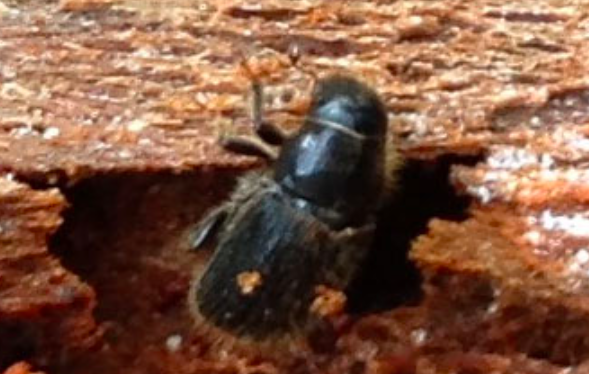DON’T IMPORT THESE BUGS INTO YOUR LIVE STANDS OF SPRUCE
If it’s summer in Alaska, it must be time to cut firewood for winter.
But with the invasion of the spruce bark beetle throughout Southcentral, are you bringing the pest to your own yard where it will kill your trees and those of your neighbors?
Probably, if you’re cutting infested spruce. Your best bet is to debark the wood before you bring it home. But who has time for that?
With spruce beetle already showing up in neighborhoods like Spenard and Turnagain in Anchorage, it may be a losing battle, but then again, knowing about the life cycle of the beetles may save that tree in your yard.
Spruce beetles infest Sitka, white, and Lutz spruce trees, and are rarely are seen in black spruce or Scots pine. They live in the layer between the bark and the wood, where they lay eggs, and the adults are only 1/4 inch long. Because they aren’t in the wood, the wood itself remains usable for construction for some time, according to the Alaska State Forester.
One female beetle may lay between 10 and 150 eggs in “galleries” and a large downed spruce tree may have 100 beetles per square food of bark.
NOW IS THE HIGH SEASON WHEN THEY ARE ON THE MOVE
The beetles emerge from infested trees and fly to new host trees from mid-May until mid-July, when temperatures are above 60 degrees. They do not attack birch, hemlock, aspen, cottonwood, or other trees.
Southcentral Alaska has up to a million acres of impacted spruce trees.
Spruce beetles prefer to attack recently wind-thrown, diseased, or weakened trees, and these are trees often used as firewood. Here’s what you need to know:
During the first winter after infestation, larvae and adult beetles may be present under the bark. During the second winter, adult beetles may be under the bark around the base of the tree and may emerge the following spring. Two years after the attack, beetles will have left the tree. So you’re looking at a two-year life cycle.
Adult beetles may jump to your nearby spruce trees if you bring home beetles in your firewood.
If you have to store firewood from last year or the year before, don’t store it next to the house or near a living spruce tree. And don’t apply pesticides to your firewood.
Here’s what the State Forester page says to do when harvesting firewood:
FRESH LOG WITH GREEN NEEDLES WHEN CUT
(Bark peels away from wood smoothly; wood not split.)
- Store only enough firewood for a single winter’s use.
- Split into stove-size pieces to dry out; stack loosely or separate to allow maximum air circulation.
- Dry wood discourages new spruce beetle attacks.
- De-bark log to eliminate potential beetle habitat.
FRESH LOG WITH GREEN NEEDLES WHEN CUT, BUT VISIBLE BEETLE ATTACKS ON BARK SURFACE
(Reddish-brown boring dust and pitch globules; bark may peel smoothly; wood not split.)
- Store only enough firewood for a single winter’s use.
- Split into stove-size pieces to dry out; stack loosely or separate to allow maximum air circulation.
- This will dry out the larvae and their food source.
- De-bark log to eliminate larvae and habitat.
DRY LOG; RUST COLORED OR NO NEEDLES PRESENT WHEN CUT
(Some evidence of old beetle attacks or woodpecker activity; bark may adhere tightly or pull off in pieces.)
- Split and use prior to next spring to kill adult beetles that will emerge at that time.
- Fire-scorch the outer portion of the bark, killing beetles beneath, but keep the bulk of the wood
- intact (messy, but intact) for future use.
- Consider preventive measures on surrounding live spruce trees.
DRY, OLD LOG OR SPLIT WOOD
(Barks pulls off loosely.)
- Spruce beetles will not attack well-seasoned wood and are normally gone from trees that have been dead for more than one year ( though beetles and other insects may enter the wood). Old wood, free of spruce beetles, is not a potential spruce beetle infestation source.
Be sure to get a permit for cutting firewood on State land. The Department of Forestry has an Online Firewood Permit System for state land in Fairbanks, Tok, Glennallen, Haines, Mat-Su, and Kenai.
Do you have Alaska life hack tips? Share them with [email protected].
